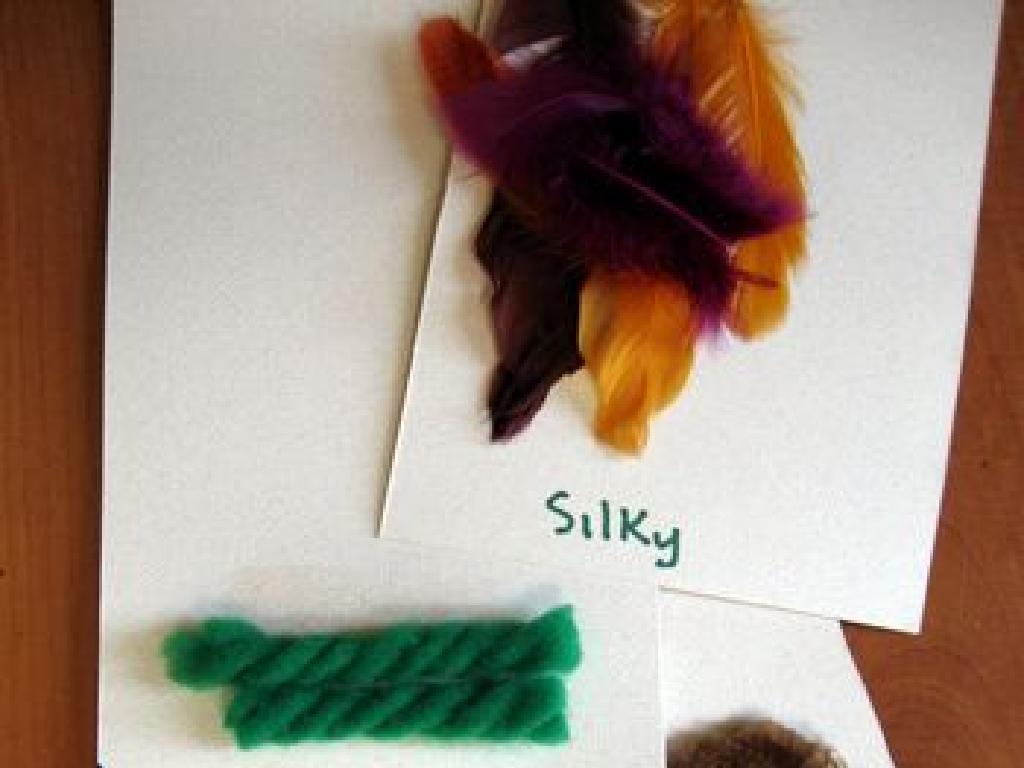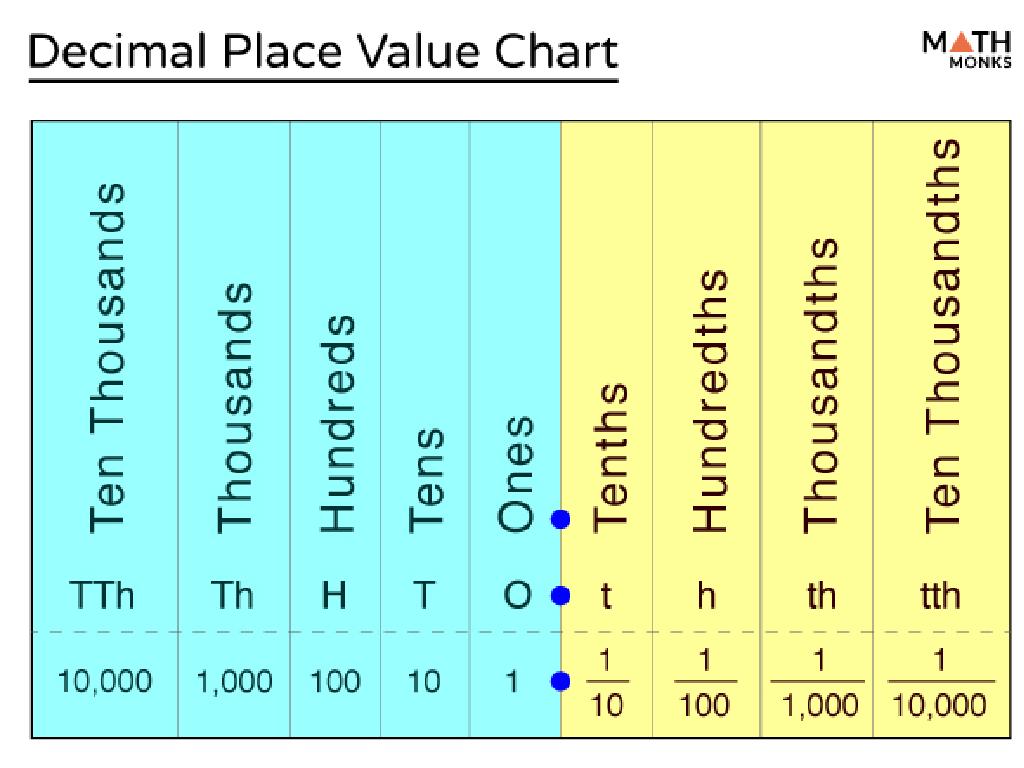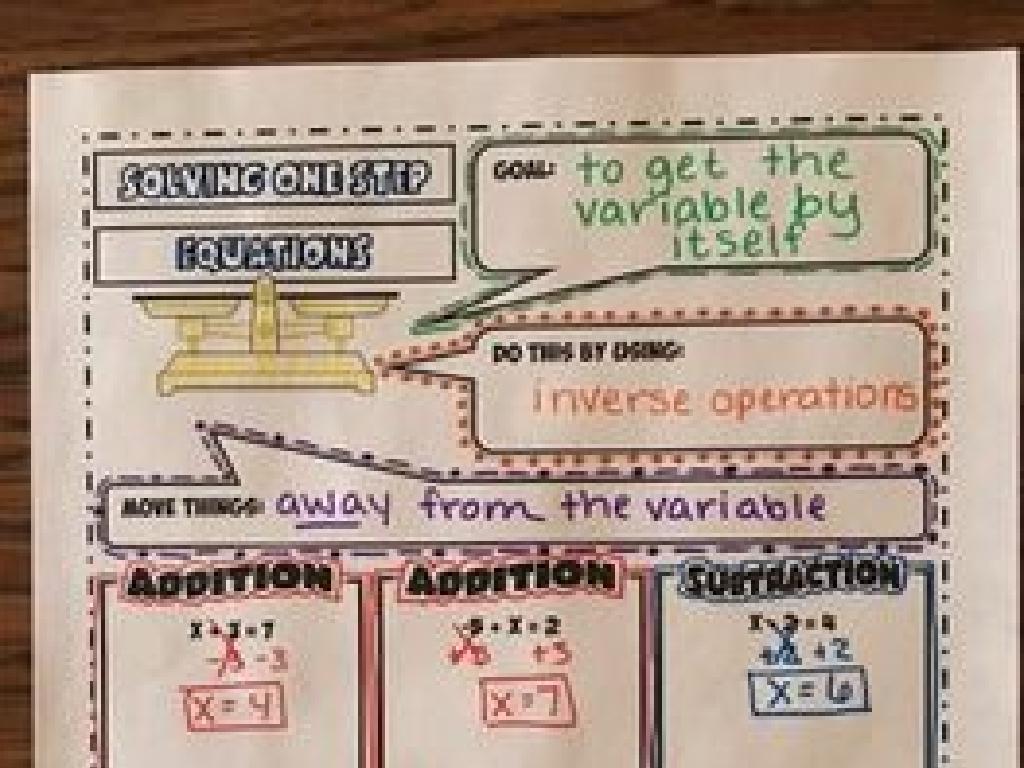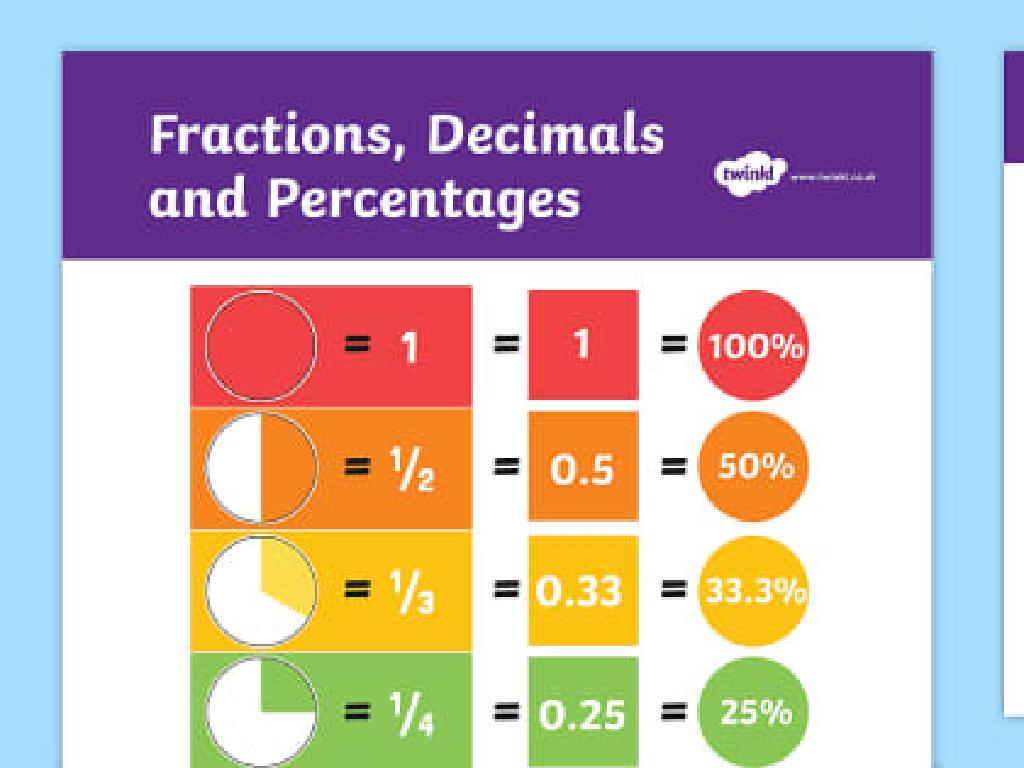Make Halves, Thirds, Fourths, Sixths, And Eighths
Subject: Math
Grade: Third grade
Topic: Understand Fractions
Please LOG IN to download the presentation. Access is available to registered users only.
View More Content
Welcome to Fractions!
– Learning about fractions
– Exploring halves, thirds, and more
– Halves are 1/2, thirds are 1/3, fourths are 1/4, etc.
– Understanding what fractions represent
– Fractions show parts of a whole, like a pizza cut into slices
– Discovering the importance of fractions
– Fractions are used in everyday life, like measuring and cooking
|
Today’s lesson introduces fractions to third graders, focusing on halves, thirds, fourths, sixths, and eighths. Begin by explaining that a fraction represents a part of a whole or a set. Use tangible examples like dividing a pizza or a chocolate bar to illustrate how fractions work. Emphasize that understanding fractions is crucial because we use them in many daily activities, such as cooking, measuring ingredients, and dividing things equally. Encourage students to think of examples where they have encountered fractions outside of school. The goal is to help students recognize fractions in their environment and understand their practical applications.
Understanding Fractions
– A fraction shows part of a whole
– Top number is the numerator
– It tells how many parts you have
– Bottom number is the denominator
– It tells how many equal parts the whole is divided into
– Fractions are all around us
– Pizza slices, a glass of water, and pieces of cake
|
Begin by explaining that a fraction represents a part of a whole, something that is not complete on its own. The numerator, the top number of a fraction, indicates how many parts of the whole we are considering. The denominator, the bottom number, tells us into how many equal parts the whole is divided. Use everyday examples to illustrate fractions, such as slices of pizza (if a pizza is cut into 8 pieces, each piece is 1/8 of the pizza), a glass of water (half full is 1/2), or pieces of a cake. This will help students visualize fractions in a context they can understand and relate to. Encourage students to find and share examples of fractions from their daily lives.
Understanding Halves
– Dividing into 2 equal parts
– Each part is called a half
– 1/2 represents a half
– Think of 1/2 as one out of two pieces
– Examples of halves
– Half an apple, or 30 minutes as half an hour
|
This slide introduces the concept of halves, which is a foundational idea in understanding fractions. Emphasize that when something is divided into two equal parts, each part is called a half. Use visual aids like cutting an apple into two equal pieces to demonstrate. Explain that the fraction 1/2 symbolizes one of those two equal parts. Provide relatable examples such as dividing a sandwich between two people or understanding half an hour as part of time. Encourage students to think of other examples of halves in their daily lives to solidify their understanding.
Understanding Thirds in Fractions
– Dividing into 3 equal parts
– Imagine cutting a cake into 3 same-size pieces.
– Each part is one third
– If you take one piece, that’s 1/3 of the cake.
– 1/3 represents a third
– 1/3 is one out of three equal parts of a whole.
– Real-life examples of thirds
– Think of sharing a pizza with two friends; each gets 1/3.
|
This slide introduces the concept of thirds to third graders. Begin by explaining that when an object is divided into three equal parts, each part is called a third. Use visual aids like a circle or a rectangle to represent a whole object and show it being divided into three equal parts. Emphasize that 1/3 means one part out of three. Provide relatable examples such as dividing a pizza or a yard into three equal parts to help students visualize and understand the concept of thirds. Encourage students to think of other examples where they might encounter thirds in their daily lives.
Understanding Fourths (Quarters)
– Fourths means 4 equal parts
– 1/4 represents one fourth
– It’s like splitting something into 4 pieces
– Example: Quarter of a dollar
– $0.25 is 1/4 of $1
– Example: Quarter of a cake
– If you cut a cake into 4 pieces, each is 1/4
|
This slide introduces the concept of fourths, also known as quarters, to help students understand that it involves dividing something into four equal parts. Emphasize that when we talk about 1/4, we mean one out of the four equal parts. Use tangible examples like a quarter of a dollar and a quarter of a cake to illustrate the concept, as these are items children can easily visualize and relate to. Encourage students to think of other examples of fourths and discuss why it’s important to make the parts equal. This will lay the groundwork for understanding fractions and their practical applications in everyday life.
Understanding Sixths
– Dividing into 6 equal parts
– Each part is one sixth
– 1/6 represents a sixth
– Imagine cutting a pizza into 6 slices; each slice is 1/6
– Examples of sixths
– One sixth of an hour is 10 minutes, one sixth of a pie is one slice out of six
|
This slide is focused on helping students understand the concept of sixths. Begin by explaining that when an object or quantity is divided into six equal parts, each part is called a sixth. Use visual aids like a pie chart or a clock to illustrate this point. Show that 1/6 is the notation we use to represent one out of six equal parts. Provide relatable examples such as dividing an hour into 10-minute increments or slicing a pie into six pieces. Encourage students to think of other things that can be divided into sixths to solidify their understanding. During the class, you can use physical objects like playdough or paper to have students create sixths and discuss their observations.
Understanding Eighths
– Dividing into 8 equal parts
– Imagine cutting a cake into 8 pieces, each piece is an eighth
– Each part is 1/8 of the whole
– When we say 1/8, it means one out of eight equal pieces
– Example: 1/8 of a pizza
– If you slice a pizza into 8 pieces, taking one gives you 1/8
– Example: 1/8 of a mile
– Running 1/8 of a mile means covering one part of eight equal parts of a mile
|
This slide introduces the concept of eighths to third-grade students. Begin by explaining that when an object is divided into 8 equal parts, each part is called an eighth. Use visual aids like a circle or a bar divided into eight sections to illustrate this. Show how 1/8 is written and explain that it represents one of those eight equal parts. Provide relatable examples such as dividing a pizza or measuring a distance to help students visualize the concept. Encourage students to think of other things that can be divided into eighths to reinforce their understanding. The goal is for students to be comfortable with the idea of eighths as a basic fraction.
Comparing Fractions
– Understanding fraction comparison
– How do 1/2, 1/3, and 1/4 stack up against each other?
– Bigger vs. smaller fractions
– A fraction is bigger if its pieces are bigger; 1/2 is bigger than 1/3.
– Using fraction strips for comparison
– Fraction strips are tools that help us see the differences in size.
– Visualizing fraction sizes
– Seeing fractions can help us understand them better.
|
This slide introduces the concept of comparing fractions, which is a fundamental skill in understanding fractions. Start by explaining that fractions represent parts of a whole and that we can compare them to see which is larger or smaller. Use fraction strips as a visual aid to help students see the differences in size between fractions like halves, thirds, fourths, sixths, and eighths. Emphasize that the larger the denominator, the smaller the pieces of the whole. Encourage students to make their own fraction strips and use them to compare different fractions. This hands-on activity will help solidify their understanding of how fractions relate to each other in size.
Fun with Fractions!: Fraction Pizza Party
– Learn to make fractions with objects
– Each student creates a paper pizza
– Use paper plates and colored markers
– Divide your pizza into fractions
– Cut the pizza into equal parts
– Show halves, thirds, fourths, sixths, eighths
– Practice naming each fraction slice
|
This activity is designed to help students visualize and understand fractions in a fun and interactive way. Provide each student with a paper plate and colored markers or crayons. Guide them to divide their ‘pizza’ into equal sections to represent halves, thirds, fourths, sixths, and eighths. They can then color each ‘slice’ and label it with the correct fraction. This hands-on activity will reinforce the concept of fractions as parts of a whole. Encourage creativity and ensure that each student understands that the slices must be equal to represent the fractions accurately. Possible variations of the activity could include using real fruit slices, construction paper to create fraction art, or even folding paper into the various fractions.
Fraction Scavenger Hunt Activity
– Find divisible classroom items
– Pair up for paper shape fractions
– Work with a partner to cut shapes like circles or rectangles
– Divide shapes into fractions
– Make halves, thirds, fourths, sixths, eighths
– Present and explain your fractions
– Discuss how you divided each shape and what each fraction represents
|
This interactive class activity is designed to help students understand fractions by finding real-life examples and creating their own. Students will work in pairs to search for items in the classroom that can be evenly divided into halves, thirds, fourths, sixths, and eighths. They will then cut out paper shapes and physically divide them into the specified fractions, which helps in visualizing and understanding the concept of fractions. After the activity, each pair will share their findings with the class, explaining the fractions they created. This will reinforce their understanding and allow them to practice using fraction terminology. Possible items for the scavenger hunt could include books (halves), pencils (thirds), paper sheets (fourths), and so on. Encourage creativity and ensure that each student participates in both the scavenger hunt and the presentation.






